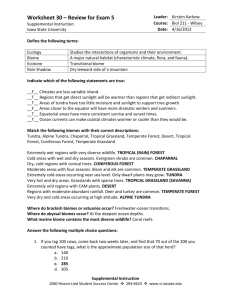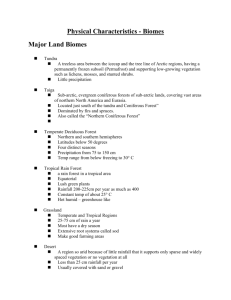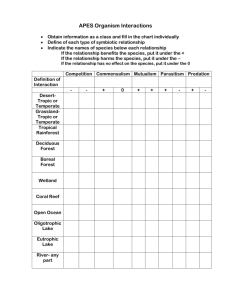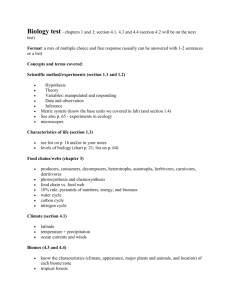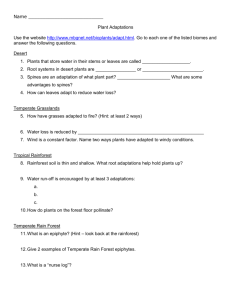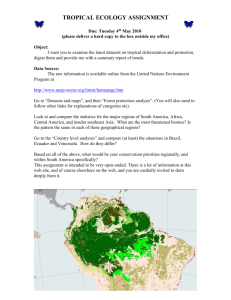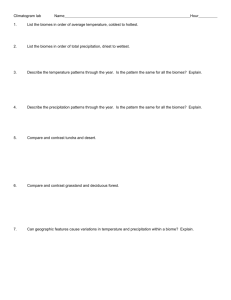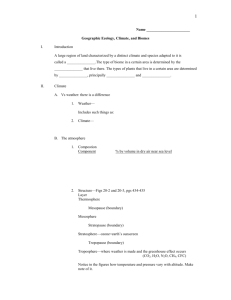Climate and Biomes
advertisement
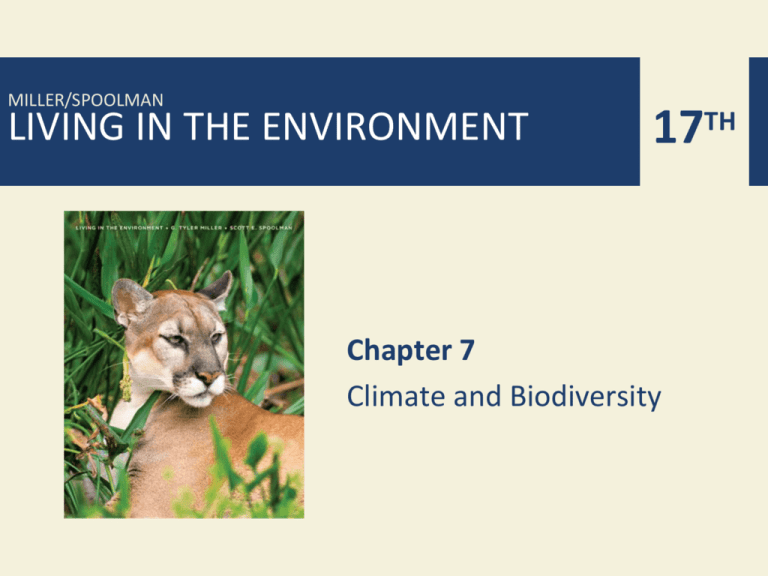
MILLER/SPOOLMAN LIVING IN THE ENVIRONMENT 17TH Chapter 7 Climate and Biodiversity Core Case Study: Different Climates Support Different Life Forms • Climate -- long-term temperature and precipitation patterns – determines which plants and animals can live where • Tropical: equator, intense sunlight • Polar: poles, little sunlight • Temperate: in-between tropical and polar Three Major Climate Zones Fig. 7-1, p. 147 7-1 What Factors Influence Climate? • Concept 7-1 Key factors that determine an area’s climate are incoming solar energy, the earth’s rotation, global patterns of air and water movement, gases in the atmosphere, and the earth’s surface features. The Earth Has Many Different Climates • Weather Set of physical conditions in the troposphere (the lower atmosphere): • Temperature, precipitation, wind speed, cloud cover, Humidity • Time Span: Hours to days • Climate • Area’s general pattern of atmospheric conditions over periods ranging from 3 decades to thousands of years. • Climate is the SUM of weather conditions in a given area, averaged over a long period of time. Natural Capital: Generalized Map of the Earth’s Current Climate Zones Fig. 7-2, p. 149 Arctic Circle Tropic of Cancer Tropic of Capricorn Antarctic Circle Polar (ice) Warm temperate Subarctic (snow) Dry Cool temperate Tropical Highland Major upwelling zones Warm ocean current River Cold ocean current Fig. 7-2, p. 149 The Earth Has Many Different Climates • Air circulation in lower atmosphere due to 1. Uneven heating of the earth’s surface by sun: Sun hits the earth more directly at the equator, so smaller areas are delivered more heat. At poles the light is indirectly angled so the heat is spread over a larger area. 2. Rotation of the earth on its axis: Equator spins faster than regions north or regions south. Locations farther from the equator spin slower. The atmosphere over these areas are divided into areas called cells. Cells: Distinguished by their differing directions of air movement. 3. Properties of air, water, and land: Heat from the sun evaporates water and transfers heat to the atmosphere. This transfer forms convection cells that circulate heat, air, and moisture from place to place and vertically. Global Air Circulation Fig. 7-3, p. 149 Moist air rises, cools, and releases moisture as rain Polar cap Cold deserts 60°N The highest solar energy input is at the equator. Solar energy Westerlies 30°N Northeast trades Evergreen coniferous forest Temperate deciduous forest and grassland Hot desert Tropical deciduous forest Equator 0° Tropical rain forest Air cools and descends at lower latitudes. Warm air rises and moves toward the poles. Tropical deciduous forest Hot desert Southeast trades 30°S Westerlies Temperate deciduous forest and grassland Cold deserts Air cools and descends at lower latitudes. 60°S Polar cap Fig. 7-3, p. 149 LOW PRESSURE Cool, dry air HIGH PRESSURE Heat released radiates to space Falls, is compressed, warms Warm, dry air HIGH PRESSURE Condensation and precipitation Rises, expands, cools Flows toward low pressure, picks up moisture and heat Moist surface warmed by sun Hot, wet air LOW PRESSURE Fig. 7-4, p. 150 Energy Transfer by Convection in the Atmosphere Fig. 7-4, p. 150 The Earth Has Many Different Climates • Ocean currents • • • • Prevailing winds Earth’s rotation Redistribution of heat from the sun due to differing densities of warm vs. cool water Surface currents and deep currents Connected Deep and Shallow Ocean Currents Fig. 7-5, p. 150 Warm, less salty, shallow current Cold, salty, deep current Fig. 7-5, p. 150 The Earth Has Many Different Climates • El Niño-Southern Oscillation • Every few years • Prevailing winds in tropical Pacific Ocean change direction • Affects much of earth’s weather for 1-2 years • Link between air circulation, ocean currents, and biomes Normal and El Niño Conditions Figure 4, Supplement 7 Impact of El Nino-Southern Oscillation Figure 5, Supplement 7 Greenhouse Gases Warm the Lower Atmosphere • Greenhouse gases • • • • H2O CO2 CH4 N2O • Natural greenhouse effect • Gases keep earth habitable • Human-enhanced global warming Flow of Energy to and from the Earth Fig. 3-4, p. 57 Earth’s Surface Features Affect Local Climates • Differential heat absorption by land and water • Land and sea breezes • Rain shadow effect • Most precipitation falls on the windward side of mountain ranges • Deserts leeward • Cities create microclimates Rain Shadow Effect Fig. 7-6, p. 152 Prevailing winds pick up moisture from an ocean. On the windward side of a mountain range, air rises, cools, and releases moisture. On the leeward side of the mountain range, air descends, warms, and releases little moisture, causing rain shadow effect. Fig. 7-6, p. 152 7-2 How Does Climate Affect the Nature and Locations of Biomes? • Concept 7-2 Differences in average annual precipitation and temperature lead to the formation of tropical, temperate, and cold deserts, grasslands, and forests, and largely determine their locations. Climate Helps Determine Where Organisms Can Live • Major biomes: large land regions with certain types of climate and dominant plant life • Not uniform • Mosaic of patches • Latitude and elevation • Annual precipitation • Temperature The Earth’s Major Biomes Fig. 7-7, p. 153 North America Biomes Figure 3, Supplement 8 Generalized Effects of Elevation and Latitude on Climate and Biomes Fig. 7-8, p. 153 Elevation Mountain ice and snow Tundra (herbs, lichens, mosses) Coniferous Forest Latitude (south to north) Deciduous Forest Tropical Forest Tropical Forest Deciduous Forest Coniferous Forest Tundra (herbs, lichens, mosses) Polar ice and snow Fig. 7-8, p. 153 Elevation Mountain ice and snow Tundra (herbs, lichens, mosses) Coniferous Forest Deciduous Forest Latitude Tropical Forest Tropical Forest Deciduous Forest Coniferous Forest Tundra (herbs, lichens, mosses) Polar ice and snow Stepped Art Fig. 7-8, p. 153 Natural Capital: Average Precipitation and Average Temperature as Limiting Factors Fig. 7-9, p. 154 Cold Arctic tundra Cold desert Evergreen coniferous forest Temperate desert Temperate deciduous forest Chaparral Hot Wet Temperate grassland Tropical desert Tropical rain forest Dry Tropical grassland (savanna) Fig. 7-9, p. 154 Global Plant Biodiversity Figure 6, Supplement 8 Tropic of Cancer High mountains Equator Polar ice Arctic tundra (cold grassland) Temperate grassland Tropical grassland (savanna) Chaparral Tropic of Capricorn Coniferous forest Temperate deciduous forest Temperate rain forest Tropical rain forest Tropical dry forest Desert Fig. 7-7, p. 153 There Are Three Major Types of Deserts 1. Tropical deserts 2. Temperate deserts 3. Cold deserts • Fragile ecosystem • • • • Slow plant growth Low species diversity Slow nutrient recycling Lack of water Climate Graphs of Three Types of Deserts Fig. 7-10, p. 155 Stepped Art Fig. 7-10, p. 155 Temperate Desert Ecosystem in North America Figure 1, Supplement 6 Science Focus: Staying Alive in the Desert • Beat the heat/every drop of water counts • Plant adaptations • Succulents • Deep tap roots • Animal strategies and adaptations • Physiology and anatomy • Behavior Wildflowers Bloom after Rain in Arizona Fig. 7-A, p. 156 There Are Three Major Types of Grasslands (1) 1. Tropical 2. Temperate 3. Cold (arctic tundra) Climate Graphs of Tropical, Temperate, and Cold Grasslands Fig. 7-11, p. 157 Stepped Art Fig. 7-11, p. 157 There Are Three Major Types of Grasslands (2) • Tropical • Savanna • Grazing animals • Browsing animals • Temperate • • • • Cold winters and hot and dry summers Tall-grass prairies Short-grass prairies Often converted to farmland Temperate Tall-Grass Prairie Ecosystem in North America Figure 2, Supplement 6 There Are Three Major Types of Grasslands (3) • Arctic tundra: fragile biome • • • • Plants close to ground to conserve heat Most growth in short summer Animals have thick fur Permafrost • Underground soil that stays frozen • Alpine tundra: above tree line in mountains Monoculture Crop Replacing Biologically Diverse Temperate Grassland Fig. 7-12, p. 158 Temperate Shrubland: Nice Climate, Risky Place to Live • Chaparral • Near the sea: nice climate • Prone to fires in the dry season There Are Three Major Types of Forests (1) 1. Tropical 2. Temperate 3. Cold • Northern coniferous and boreal Climate Graphs of Tropical, Temperate, and Cold Forests Fig. 7-13, p. 160 Stepped Art Fig. 7-13, p. 160 There Are Three Major Types of Forests (2) • Tropical rain forests • • • • • Temperature and moisture Stratification of specialized plant and animal niches Little wind: significance Rapid recycling of scarce soil nutrients Impact of human activities Tropical Rain Forest Ecosystem Fig. 7-14, p. 161 Blue and gold macaw Ocelot Harpy eagle Climbing monstera palm Slaty-tailed trogon Squirrel monkeys Katydid Tree frog Green tree snake Snail Ants Bacteria Bromeliad Fungi Producer to primary consumer Primary to secondary consumer Secondary to higher-level consumer All producers and consumers to decomposers Fig. 7-14, p. 161 Niche Stratification in a Tropical Rain Forest Fig. 7-15, p. 162 45 Emergent layer Harpy eagle 40 35 Toco toucan Canopy Height (meters) 30 25 20 Understory Wooly opossum 15 10 Brazilian tapir 5 0 Black-crowned antpitta Shrub layer Ground layer Fig. 7-15, p. 162 There Are Three Major Types of Forests (3) • Temperate deciduous forests • • • • Temperature and moisture Broad-leaf trees Slow rate of decomposition: significance Impact of human activities Temperate Deciduous Forest Ecosystem in North America Figure 4, Supplement 6 There Are Three Major Types of Forests (4) • Evergreen coniferous forests: boreal and taigas • Temperature and moisture • Few species of cone: bearing trees • Slow decomposition: significance • Coastal coniferous forest • Temperate rain forests Evergreen Coniferous Forest Ecosystem in North America Figure 5, Supplement 6 Temperate Rain Forest in Washington State Fig. 7-16, p. 163 Mountains Play Important Ecological Roles • Majority of the world’s forests • Islands of biodiversity • Habitats for endemic species • Help regulate the earth’s climate • Major storehouses of water • Role in hydrologic cycle Mount Rainier National Park in Washington State Fig. 7-17, p. 163 7-3 How Have We Affected the Word’s Terrestrial Ecosystems? • Concept 7-3 In many areas, human activities are impairing ecological and economic services provided by the earth’s deserts, grasslands, forests, and mountains. Humans Have Disturbed Most of the Earth’s Lands • Deserts • Grasslands • Forests • Mountains Major Human Impacts on Terrestrial Ecosystems Fig. 7-18, p. 165 Natural Capital Degradation Major Human Impacts on Terrestrial Ecosystems Deserts Large desert cities Grasslands Forests Conversion to cropland Clearing for agriculture, livestock grazing, timber, and urban development Destruction of soil and underground habitat by Release of CO2 to off-road vehicles atmosphere from burning grassland Soil salinization from irrigation Depletion of groundwater Land disturbance and pollution from mineral extraction Mountains Agriculture Timber and mineral extraction Hydroelectric dams and reservoirs Conversion of diverse forests to tree Increasing tourism Overgrazing by plantations Air pollution blowing in from urban livestock areas and power plants Damage from offOil production and road vehicles Soil damage from off-road off-road vehicles vehicles Pollution of forest in arctic tundra streams Water supplies threatened by glacial melting Fig. 7-18, p. 165 NATURAL CAPITAL DEGRADATION Major Human Impacts on Terrestrial Ecosystems Deserts Grasslands Forests Clearing for Large desert cities Conversion agriculture, to cropland Soil destruction by Release of CO2 livestock grazing, off-road vehicles to atmosphere timber, and urban from burning development Soil salinization grassland Conversion of from irrigation diverse forests to Overgrazing tree plantations Depletion of by livestock groundwater Damage from offOil production road vehicles Land disturbance and off-road and pollution from vehicles in Pollution of mineral extraction arctic tundra forest streams Mountains Agriculture Timber extraction Mineral extraction Hydroelectric dams and reservoirs Increasing tourism Urban air pollution Increased ultraviolet radiation from ozone depletion Soil damage from off-road vehicles Stepped Art Fig. 7-18, p. 165 Three Big Ideas 1. Differences in climate, based mostly on long-term differences in average temperature and precipitation, largely determine the types and locations of the earth’s deserts, grasslands, and forests. 2. The earth’s terrestrial systems provide important ecological and economic services. Three Big Ideas 3. Human activities are degrading and disrupting many of the ecological and economic services provided by the earth’s terrestrial ecosystems.
